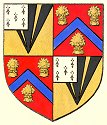 |
A SHORT HISTORY OF TETTENHALL8. The canal and the turnpike |
|
 |
A SHORT HISTORY OF TETTENHALL8. The canal and the turnpike |
|
|
In the mid eighteenth century canals carne to be seen as the answer to
the transport problems of the new industrialists, both for moving raw
materials in and for moving finished goods out. They were also seen as
important to the new style farming, moving manure and fertilisers in and
produce out.
The Staffs and Worcs Canal, linking the Severn and the Trent, was one of
the earliest of the new canals. It was begun in 1776 and its engineer
was James Brindley. In Tettenhall its course largely followed that of
the Smestow. On the 1st September 1776 the first sod was ceremoniously
cut at Compton. The Compton Lock is believed to be the first lock ever
built by Brindley.
In 1770 the first part of the canal, from Stourport to Compton, was
opened; and the remainder followed two years later. As Compton was the
nearest canal to Wolverhampton a great deal of the town’s trade started
to pass through it. In due course the Wolverhampton Town Commissioners
opened up Darlington Street to improve access to the canal. Outside the
town the road came under the aegis of the Wolverhampton Turnpike Trust.
The chairman of the trust was Francis Holyoake, a Wolverhampton
solicitor and Tettenhall resident. Sir John Wrotteseley was one of the
Trustees. The trust improved both Compton Road and Tettenhall Road - the
links between Tettenhall and Wolverhampton were getting stronger. Tettenhall was almost exactly half way between London and Holyhead, the main passenger port for Ireland. The old Holyhead Road came from Wolverhampton, along Tettenhall Road, crossing the Smestow on a bridge about 20 yards east of the present Newbridge. It then turned up Old Hill, the steepness of which caused it to be a notorious problem, and so through the village and out again, rejoining the present line of the Shifnal Road near the Summerhouse.
The road became of even greater importance after the Act of Union with Ireland in 1801 which created 100 Irish MPs, all of whom used the road to attend Parliament. They had sufficient political clout to ensure that the Holyhead Road was improved and in due course Parliament authorised Thomas Telford to improve the whole road. His plan for dealing with Old Hill was to make a new line of road out of Wolverhampton to Aldersley and then on to the Wergs, thus by passing the ridge altogether.
Telford had to act through the local turnpike trusts and parishes. Hollyoake and the turnpike trustees rejected Telford’s scheme and then rejected another which would have created a short tunnel rising through the ridge. They then put up their own plan which, since Telford disapproved of it, they had to build themselves. It was this scheme which created the present road: a deep cutting was created at the top of the ridge and the spoil from the cutting was used to make a rising embankment at the bottom of the ridge.
The work was completed in 1823 and Telford agreed, somewhat grudgingly,
that it was at least an improvement. One effect of the new road was to
somewhat isolate the original nucleus of the village, around the church,
from the newer part at Upper Green. |